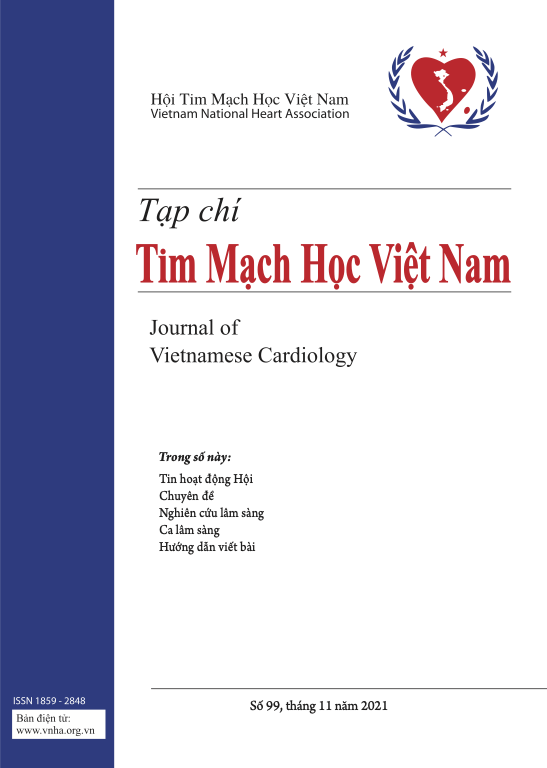Survey on blood glucose and electrolyte levels in patients with acute myocarditis treated at Bach Mai Hospital
DOI:
https://doi.org/10.58354/jvc.112E.2024.879Từ khóa:
Acute myocarditis, arrhythmias in patients with acute myocarditisTóm tắt
Background and Objectives:
Myocarditis is a condition characterized by inflammation of the heart muscle tissue due to various causes, with viruses being a common cause. During the progression of the disease, damage to the heart muscle can lead to acute heart failure, dangerous arrhythmias, cardiogenic shock, or even cardiac arrest, which can result in rapid death. Clinical markers such as chest pain, shortness of breath, and arrhythmias, along with diagnostic tools like electrocardiograms and cardiac ultrasounds, play a crucial role in diagnosing and predicting the disease. In addition to monitoring vital signs, tracking blood glucose and electrolyte levels is an important criterion for nurses in managing patients with acute myocarditis. This aids in making appropriate care and treatment decisions for each specific patient. The study aims to investigate blood glucose and electrolyte levels and their relationship with the severity of heart failure and ventricular arrhythmias in patients with acute myocarditis.
Methods:
A retrospective review was conducted on the records of 119 patients with acute myocarditis treated at Bach Mai Hospital from 2017 to 2021. Biochemical results were included in a regression model to assess their correlation with the occurrence of adverse clinical outcomes during hospitalization.
Results:
Among the 119 patients (66.4% male; average age 33.93 ± 15.87 years), significant electrolyte disturbances included severe hyponatremia (6.7%), severe hypokalemia (5.8%), hyperkalemia (8.1%), and blood glucose disorders (31.1%). Severe hyponatremia was found to be predictive of ventricular arrhythmias and in-hospital mortality. Severe hypokalemia was also predictive of ventricular arrhythmias and in-hospital mortality. Hyperkalemia was associated with a higher risk of ventricular arrhythmias. Patients with severe conditions requiring intensive care, such as intravenous feeding or intravenous insulin administration, demonstrated a higher risk of in-hospital mortality.
Conclusion:
Severe electrolyte disturbances, such as severe hyponatremia, severe hypokalemia, and hyperkalemia, have prognostic significance in patients with acute myocarditis.
Tài liệu tham khảo
Gore I, Saphir O. Myocarditis; a classification of 1402 cases. Am Heart J. 1947;34(6):827-830. doi:10.1016/0002-8703(47)90147-6
![]()
Sagar S, Liu PP, Cooper LT Jr. Myocarditis. Lancet. 2012;379(9817):738-747. doi:10.1016/S0140-6736(11)60648-X
![]()
Doolan A, Langlois N, Semsarian C. Causes of sudden cardiac death in young Australians. Med J Aust. 2004;180(3):110-112. doi:10.5694/j.1326-5377.2004.tb05830.x
![]()
Caforio AL, Pankuweit S, Arbustini E, et al. Current state of knowledge on aetiology, diagnosis, management, and therapy of myocarditis: a position statement of the European Society of Cardiology Working Group on Myocardial and Pericardial Diseases. Eur Heart J. 2013;34(33):2636-2648d. doi:10.1093/eurheartj/eht210
![]()
Ali K, Workicho A, Gudina EK. Hyponatremia in patients hospitalized with heart failure: a condition often overlooked in low-income settings. Int J Gen Med. 2016;9:267-273. doi:10.2147/IJGM.S110872
![]()
Luo J, Brunelli SM, Jensen DE, et al. Association between Serum Potassium and Outcomes in Patients with Reduced Kidney Function. Clin J Am Soc Nephrol. 2016;11(1):90-100. doi:10.2215/CJN.01730215
![]()
Guzmán-Bofarull J, Forado-Benatar I, Farrero M. 4A score: prognostic value of clinical assessment in paucisymptomatic tricuspid regurgitation. Rev Esp Cardiol (Engl Ed). 2023;76(11):838-840. doi:10.1016/j.rec.2023.05.012
![]()








